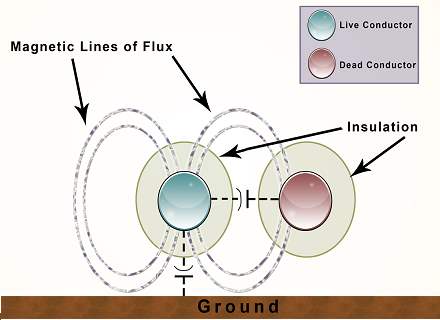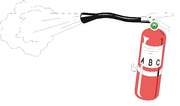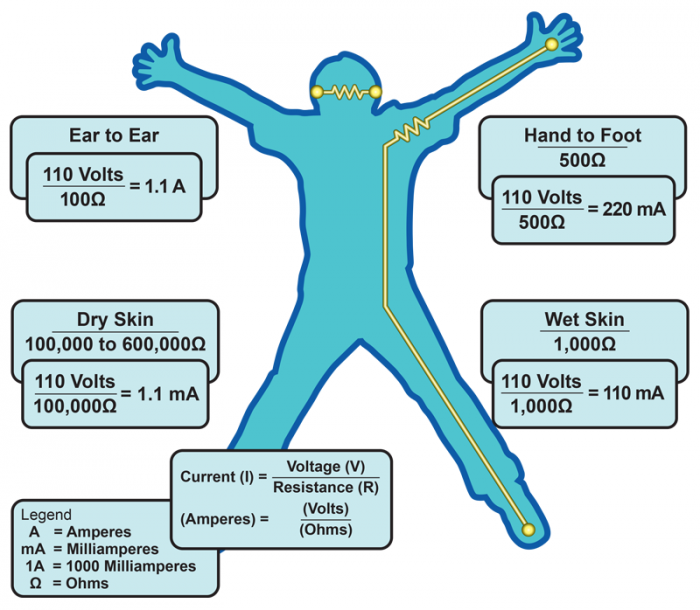According to the National Institute of Occupational Safety & Health (NIOSH), electrical hazards cause more than 300 deaths and 4,000 injuries in the workplace each year. Electrical accidents are ranked 6th among all causes of work related deaths in the United States. Always work safely, wearing the proper PPE for your situation and know what is happening in your surroundings at all times!
Electrical Hazards
There are many safety hazards to be found in the electrical shop or in the field. The most obvious are electrical hazards and all the things you can see and hear. Other hazards that must be considered are confined spaces, oil and other fire hazards, and compressed gas and air systems.
Electrostatic Coupling
A common phenomenon of high-voltage electricity is electrostatic coupling. This is the static voltage or charge impressed upon nearby equipment by an energized high voltage line or bus. The electrical field that is created by current in one conductor can induce voltages into nearby, otherwise de-energized conductors. Figure 1 illustrates this coupling.

Figure 1: Electrostatic Coupling
Effects of Electrostatic Coupling
Electrostatic coupling can have several effects. First, the coupling that occurs in the isolated cable is a path for current. Second, it can build a charge because of the capacitive effect and discharge when contacted by a technician. Although this in itself is rarely of sufficient capacity to harm the individual, it can startle you and cause you to make contact with another circuit that is energized from a live source. Again, the use of temporary grounds eliminates this effect.
Capacitors
Capacitors are far too often overlooked as a source of voltage when checking de-energized circuits. Since capacitors store energy, voltage may still be present even after the circuit has been de-energized. When preparing to service a circuit that contains capacitors, it should be done in the following sequence:
- Verify, using schematics and diagrams, the location of capacitors in the circuits.
- Isolate the capacitors by opening the breakers or isolation devices connecting them to the system.
- If the capacitors have internal drain capacity, allow five to ten minutes for the capacitor to drain.
- Short circuit and ground the capacitor by first connecting a conductor to ground and to the capacitor.
Electrical Arcs
Electrical arcs are an extremely dangerous hazard. Too many times, personnel injury has occurred from exposure to an arc that should not have happened and was not expected. This occurrence should always be prepared for by using the correct protective clothing and eye protection. Severe burns and permanent eye damage can be avoided by simply using protective clothing and eye protection.
Burns
Besides the hazards of burns from being near arcs, many injuries occur from direct contact with overheated electrical equipment. A good method to check electrical equipment for overheating is to use the back of your hand to check surfaces. A thumb rule to remember is if you cannot hold the back of your hand to a surface for more than ten seconds, it is hotter than 150 degrees.
Batteries
A storage battery is constantly alive electrically and is a source of electrical shock. Care must be taken to avoid contacting the positive and negative terminals. Tools and test equipment should never be laid down on top of batteries because of the danger of extreme short circuit currents.

Smoking should never be permitted in a battery charging room or sub-station control house, since all storage batteries generate hydrogen gas during a charge. Ventilation should always be maintained in these areas to prevent a buildup of explosive gas concentration. The NEC states that provisions will be made for sufficient diffusion and ventilation of gases from the battery to prevent the accumulation of an explosive mixture.
Always avoid contact with the battery acid (electrolyte). The acid is highly corrosive to any material contacted, and dangerous if ingested. It can also irritate soft tissue, such as the face or eyes. If contact with the eyes occurs, an emergency eyewash facility should be used to flush the acid from the eyes. A good neutralizer to use in washing it away from metals, floors, and the tops of the battery cases is a solution of bicarbonate soda and water.
Electrical Fires
In almost all cases of fire in electrical equipment, removing the power from the component circuit will stop the fire. Removing the power is the same as removing the fuel. If an electrical fire continues after removing the power, insulation material or debris in the vicinity are usually burning. In any case, you should always extinguish any other material on fire and then cool the area to prevent a re-ignition of the fire.

The most effective extinguisher for use in an electrical fire is a fire extinguisher rated for a Class C fire. The CO2 and dry chemical extinguishers are both rated Class C. The biggest advantage of using a CO2 extinguisher is that it will not severely damage any of the electrical circuits it contacts.
A dry chemical extinguisher is corrosive and if it is not completely and immediately removed from all surfaces, it will damage any metal it contacts.
The use of water should be restricted to an extreme emergency, and then only by trained fire fighters capable of dealing with an out of control fire.
Important safety tips to remember about the CO2 and dry chemical extinguishers:
- The effective range of a 15-pound, CO2 extinguisher is 2 to 5 feet and it will only last for about 40 to 45 seconds on a continuous discharge.
- DO NOT confine yourself to an area with CO2. It displaces the oxygen and could cause you to lose consciousness if you are exposed to it for very long. A large fire could require the use of several CO2 extinguishers.
- A dry chemical extinguisher has a maximum range of about 15 feet and it will only last about 30 seconds on a continuous discharge.
- A problem encountered when using a dry chemical extinguisher is the effect it has on breathing. It does not displace oxygen, but if a large amount is used or it is used in a confined space, the heavy powder it disperses in the air makes it difficult to breathe.
If a transformer containing PCBs is on fire, leave the area and report the fire. When heated above 175° F, PCBs produce phosgene gas. Phosgene gas is toxic and you should not take any action to try to extinguish it yourself. In addition, you should warn the Fire Department of this when they arrive to fight the fire. This will ensure they are wearing the proper respiratory equipment.
If you find a fire, no matter what the cause, you should ”immediately” report it. Always try to remember the plant’s emergency number to report a fire or any accident. This emergency number should be posted close to the telephone, if not directly on it. Other emergency actions you can perform for an electrical fire are:
- De-energize the component or circuit that is affected.
- Turn off ventilation to the area.
If you cannot extinguish the fire using a CO2 or dry chemical extinguisher, you should leave the immediate area and wait for the fire department.

The Need for Electrical Safety
The obvious need for electrical safety is to prevent personnel from being exposed to electricity in an uncontrolled manner that may result in injury or death. Some other concerns are preventing damage to equipment and maintaining power service stability and continuity, but the most important is that of the effects of electrical current and high electrical potentials on the human body.
Most people are aware of the fact that the principal danger from electricity is electrocution, but few people understand just how small an amount of current flow is actually required for serious injury or death to occur. To understand these effects, we must look at the factors that affect the severity of a shock.
Current Effects on the Body
When current flows through the human body, the person is subjected to an electrical shock. Electrical shock can range from a slight tingling sensation to a feeling of a severe blow. The amount of current flow through the body and the duration of the current flow affects the body in different ways. Have you ever wondered why you can touch both posts of a 12-volt car battery that can produce an electrical current of several hundred amperes, and not feel any sensation of electrical shock? The answer is resistance. Dry skin has a resistance level of 100,000 to 600,000 Ω. Recall from Ohm’s law that current flow is calculated by dividing the voltage level by the total resistance. If we divide the battery voltage (12V) by the lower figure of skin resistance (100,000 Ω), we find that the current flow is .00012 amperes. Although there is current flow, it is of such a small value that it is not felt. Figure 2 below shows typical body resistances and the expected current flow through various paths through the human body when the voltage level is 100 volts.

Figure 2: Typical Body Resistances and Current Flows
Reducing Electric Shock Hazards
The best way to prevent an electrical shock is to maintain proper distance between current-carrying conductors and any part of your body. This is not always possible. During routine operations, operators and technicians are often required to operate or work on electrical equipment. Because of the possibility of an electrical shock, special precautions are observed:
- Only qualified personnel are permitted to operate or perform maintenance on electrical equipment.
- Guards should be installed on all equipment to protect personnel from accidental contact with a live conductor.
- Grounds should be installed on all electrical equipment casings. Grounds provide a low-resistance path for current to flow to earth. If the equipment is shorted to its casing, the current flows through the equipment ground and not through personnel touching it.
- Whenever possible, de-energize electrical circuits or components prior to performing work on them. This may not be as simple as it seems. Many control circuits are very complex and may have several sources of power. De-energizing a circuit may involve opening circuit breakers, pulling fuses, opening disconnects, or lifting electrical leads. Electrical schematics must be thoroughly researched by qualified personnel to identify all sources of power.
- All electrical equipment should be considered energized until proven de-energized by qualified personnel. This should be accomplished by checking the circuits and conductors for voltage prior to commencing any work. Check for voltage phase-to-phase and each phase-to-ground.
Follow proper electrical safety precautions while working on or around potentially energized circuits.
Common Safety Equipment
In learning about protective equipment that you should wear, some discussion must be made about personal items that you should not wear and the tools that you should not use.
The following personal items should not be worn when working on or around electrical equipment:
- Metal jewelry such as rings, bracelets, necklaces, watches, tie clips, etc.
- Key chains
- Ear muffs with metal frames or connecting strips
The following tools are prohibited for use around electrical equipment due to their conductive nature and the potential for shock hazard should they contact an energized circuit:
- Metal ladders
- Metal rules
- Cloth or wood rules with metal strands
- Metal fish tapes
- Metal flashlights
- Metal work lamps
There are acceptable substitutes for each of the prohibited items. Ladders made of wood or fiberglass are non-conductive and approved for use around electrical equipment. Tape measures made of cloth or plastic, and fish tapes made of plastic should be used instead of metal. Plastic or rubber-cased flashlights and work lamps are a safe alternative to the metal-cased lights.
OSHA Requirements and Rules
OSHA addresses the use of protective equipment, apparel, and tools in article 1910.335a. This article is divided into two parts: ”Personal Protective Equipment” and ”General Protective Equipment and Tools.”
The first section, ”Personal Protective Equipment”, proposes the following requirements:
- Employees working in areas where there are potential electrical hazards shall be provided with, and shall use, electrical protective equipment that is appropriate for the specific parts of the body to be protected and for the work to be performed.
- Protective equipment shall be maintained in a safe, reliable condition and shall be periodically inspected or tested, as required by 1910.137.
- If the insulating capability of protective equipment may be subject to damage during use, the insulating material shall be protected.
- Employees shall wear non-conductive head protection wherever there is a danger of head injury from electric shock or burns due to contact with exposed energized parts.
- Employees shall wear protective equipment for the eyes or face wherever there is danger of injury to the eyes or face from electric arcs, or flashes, or from flying objects resulting from electrical explosion.
The second section, ”General Protective Equipment and Tools”, proposes the requirements listed below:
- When working near exposed energized conductors or circuit parts, each employee shall use insulated tools or handling equipment if the tools or handling equipment might make contact with such conductors or parts. If the insulating capability of insulated tools or handling equipment is subject to damage, the insulating material shall be protected. Insulate tools with electrical tape. Half-wrap at least two layers of electrical tape to insulate the tools.
- Fuse handling equipment, insulated for the circuit voltage, shall be used to remove or install fuses when the fuse terminals are energized.
- Ropes and hand lines used near exposed energized parts shall be non-conductive.
- Protective shields, protective barriers, or insulating materials shall be used to protect each employee from shock, burns, or other electrically related injuries while that employee is working near exposed energized parts which might be accidentally contacted, or where dangerous electric heating or arcing might occur. When normally enclosed live parts are exposed for maintenance or repair, they shall be guarded to protect unqualified persons from contact with the live parts.
For more information on Electrical Safety, sign up for our online training at www.myodesie.com or contact us at sales@techtransfer.com for a class at your facility.

